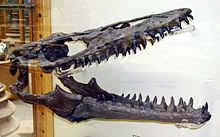Plioplatecarpus: відмінності між версіями
Перейти до навігації
Перейти до пошуку
Вилучено вміст Додано вміст
Sehrg (обговорення | внесок) Створена сторінка: {{Automatic taxobox | fossil_range = пізня крейда, {{Fossil range|73|66}} | image = Mosasaur skull.JPG | image_caption = череп ''P. primaevus'' | display_parents = 2 | taxon = Plioplatecarpus | authority = Dollo, 1882 | subdivision_ranks = Види | subdivision = *{{extinct}}'''''P. marshi''''' <small>Dollo, 1882 ({{тип}})</small> *{{extinct}}'''''P. depressus''''' <small>(Cope, 1869)</small> *{{extinct}}'''''P. primaevus''''' <sm... |
(Немає відмінностей)
|
Версія за 11:52, 16 лютого 2023
| Plioplatecarpus | |
|---|---|

| |
| череп P. primaevus | |
| Біологічна класифікація | |
| Царство: | Тварини (Animalia) |
| Тип: | Хордові (Chordata) |
| Клас: | Плазуни (Reptilia) |
| Ряд: | Лускаті (Squamata) |
| Клада: | †Mosasauria |
| Надродина: | †Mosasauroidea |
| Родина: | †Мозазаврові (Mosasauridae) |
| Підродина: | †Plioplatecarpinae |
| Триба: | †Plioplatecarpini |
| Рід: | †Plioplatecarpus Dollo, 1882 |
| Види | |
| Синоніми | |
| |

Plioplatecarpus — рід мозазаврів. Як і всі мозазаври, він жив у пізньому крейдяному періоді, приблизно 73–68 мільйонів років тому. Plioplatecarpus був мозазавром середнього розміру, з P. marshi розміром 5.5 метрів і P. houzeaui розміром 5–6 метрів[1][2].
У 1999 році Холмс і його колеги описали неповний зразок Plioplatecarpus з неморських родовищ, припускаючи, що цей рід міг потрапити в прісноводні та гирлові місця проживання[3]. Хоча описувачі Pannoniasaurus вважали це «стохастичним явищем без екологічних наслідків»[4], Тейлор і його колеги в 2021 році вважали, що цей зразок і Pannoniasaurus безпосередньо підтримують «заселення мозазавром прибережних і річкових середовищ»[5].
Примітки
- ↑ Russell, Dale. A. (06.11.1967). Systematics and Morphology of American Mosasaurs (PDF). Bulletin of the Peabody Museum of Natural History (Yale University): 209—210.
- ↑ Schulp, A. S.; Vonhof, H. B.; van der Lubbe, J. H. J. L.; Janssen, R.; van Baal, R. R. (2013). On diving and diet: resource partitioning in type-Maastrichtian mosasaurs. Netherlands Journal of Geosciences - Geologie En Mijnbouw. 92 (2–3): 165—170. doi:10.1017/s001677460000010x.
- ↑ Holmes, Robert; Caldwell, Michael W.; Cumbaa, Stephen L. (1999). A new specimen of Plioplatecarpus (Mosasauridae) from the lower Maastrichtian of Alberta: comments on allometry, functional morphology, and paleoecology. Canadian Journal of Earth Sciences. 36 (3): 363—369. doi:10.1139/e98-112.
- ↑ Makádi, L. S.; Caldwell, M. W.; Ősi, A. (2012). Butler, Richard J (ред.). The First Freshwater Mosasauroid (Upper Cretaceous, Hungary) and a New Clade of Basal Mosasauroids. PLOS ONE. 7 (12): e51781. Bibcode:2012PLoSO...751781M. doi:10.1371/journal.pone.0051781. PMC 3526648. PMID 23284766.
{{cite journal}}: Обслуговування CS1: Сторінки із непозначеним DOI з безкоштовним доступом (посилання) - ↑ Taylor, L.T.; Minzoni, R.T.; Suarez, C.A.; Gonzalez, L.A.; Martin, L.D.; Lambert, W.J.; Ehret, D.J.; Harrell, T.L. Oxygen isotopes from the teeth of Cretaceous marine lizards reveal their migration and consumption of freshwater in the Western Interior Seaway, North America. Palaeogeography, Palaeoclimatology, Palaeoecology. 573. doi:10.1016/j.palaeo.2021.110406.
| |||||||||||||||||||||||||||||||||||||||||||
|
